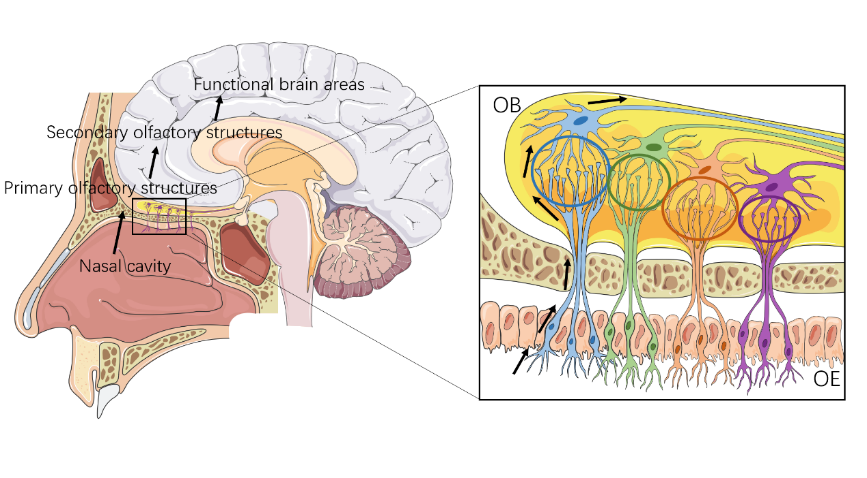NRR:南通大学张小玲和刘名轩团队提出嗅觉功能障碍是帕金森病临床前期的重要生物学标志
撰文:张小玲,顾莹莹,刘名轩
帕金森病是一种常见的老年退行性神经疾病,其主要的神经病理学特征是黑质纹状体中多巴胺神经元的退行性死亡[1]。嗅觉障碍是帕金森病早期最为常见的非运动特征之一。根据α突触核蛋白相关病理学的定义,它最初在大脑内从嗅球、前嗅核、舌咽神经和迷走神经的背侧运动核复合体开始传播,而后才涉及黑质纹状体运动复合体[2]。尽管嗅觉功能障碍的致病因素尚不清楚,但不可否认其与衰老、吸烟、过度饮酒、鼻窦疾病和神经退行性疾病有关。正常的衰老过程伴随着嗅觉功能障碍,而在帕金森病病理发展过程中,嗅觉功能障碍的风险随年龄增长而增加[3]。探索嗅觉功能障碍的机制,揭示其与神经退行性疾病之间的联系至关重要。
来自中国南通大学张小玲和刘名轩团队在《中国神经再生研究(英文版)》(Neural Regeneration Research)上发表了题为“Olfactory dysfunction and its related molecular mechanisms in Parkinson’s disease”的综述。该文明确解释了嗅觉功能障碍可作为帕金森病早期生物标志物的病因和医学定义。此外,结合临床嗅觉测试、动物模拟实验和神经递质表达水平,进一步评估了两者的相关性。进而探讨了嗅觉功能障碍在帕金森病早期病理过程中的分子机制,并通过改善嗅觉功能障碍的恶化来寻找治疗帕金森病的有效靶点。该文提示,嗅觉功能障碍是帕金森病临床前期的重要生物学标志。因此,在帕金森病的前期,开发针对嗅觉功能障碍等非运动症状的帕金森病治疗药物或可预防或延缓多巴胺能神经变性和运动症状,从而为有效治疗帕金森病提供可能。
嗅觉是一种由嗅神经系统和三叉神经系统协调的感觉器官,通过嗅神经(第一脑神经)把周围化学刺激传送到大脑的嗅觉中枢(图1)。随后,嗅觉中枢将信号传递到大脑的边缘系统(limbic system),通过整合味觉和嗅觉信号,从而给予个体不同的味觉感受[4, 5]。在特发性帕金森病中,评估患者的嗅觉阈值,发现三叉神经通路比嗅觉系统受损更少[6]。由于嗅觉系统和三叉神经之间可能存在信息交换,帕金森病和非帕金森嗅觉障碍患者的2个化学感觉系统之间的相互作用模式存在于鼻粘膜、嗅球和中枢神经系统[7]。在解剖学上,嗅觉神经可将嗅觉冲动传递给嗅球,且嗅觉系统任何部位的病变都可能导致信号传导中断[8]。因此,嗅球可能被确定为帕金森病早期嗅觉损害的区域之一。嗅球结构和周围区域的实验结果显示,帕金森病患者的嗅球体积明显减少[9],表明嗅球可作为帕金森病早期症状药物递送的靶标。嗅球是一种处理气味信息的结构,并包含许多嗅觉受体,其中从鼻腔延伸的嗅轴突将嗅觉信息传递给神经元,这是嗅觉信息到达大脑皮层之前的最后阶段[10]。嗅觉系统与外部环境相连,一旦对环境中有害因素的反应能力降低,嗅觉系统直接暴露于病原体和有毒物质的可能性增加,这将成为嗅觉病变发展的合适起点。由于整个嗅觉系统中的各种组织不仅相互协调,而且还与其他非嗅觉大脑区域紧密相连,因此它们可能为病原体从嗅球传播到大脑的其他结构提供通路[11]。

图1嗅觉分子信号可通过嗅球像脑递送的传递过程及嗅觉神经元的多样性(图源:Gu et al., Neural Regen Res, 2024)
在路易囊泡和对照组帕金森病病例的嗅球和相关结构中发现了α突触核蛋白病理学。α突触核蛋白是一种突触前神经末梢蛋白,其最常见和最重要的蛋白质修饰是磷酸化[12]。α突触核蛋白水平升高可能会破坏多巴胺信号传导。此外,α突触核蛋白表达的增加也与多巴胺再摄取减少和多巴胺转运蛋白功能降低有关,表明α突触核蛋白可能通过某种机制破坏多巴胺转运蛋白的正常功能。有研究提出,α突触核蛋白可与黑质纹状体部位的多巴胺能神经元中神经黑色素的脂质成分结合以促进其自我聚集[13]。α突触核蛋白过表达和异常积累可导致帕金森病的持续病变。将α突触核蛋白原纤维显微注射到啮齿动物嗅球中,以嗅觉途径作为病理载体,可传播病理蛋白到黑质以及帕金森病后期涉及的其他脑区[14]。此外,谷氨酸能神经传递可选择性调节改变了细胞外α突触核蛋白水平,表明该特定神经网络参与了α突触核蛋白的活动依赖性释放机制。尽管α突触核蛋白的释放可被神经元活动严格调节,但突触囊泡分泌的增加能够增加α突触核蛋白的释放。寻找靶向α突触核蛋白异常积累的药物有望治疗神经退行性疾病的初始症状。根据蛋白积累的过程,可通过减少合成和积累,增加降解等途径来降低α突触核蛋白的水平等[15]。不同神经递质之间的相对稳定性至关重要。例如,乙酰胆碱和多巴胺系统功能之间的不平衡可导致严重的神经系统疾病[16]。一旦多巴胺水平逐渐降低,其作用会减弱,乙酰胆碱功能系统变得相对兴奋,从而表现出帕金森病症状。研究表明,嗅觉功能障碍是帕金森病早期的生物标志物之一,且乙酰胆碱和多巴胺间存在独特联系。虽然帕金森病嗅觉减退的确切机制尚不清楚,但帕金森病不同脑区中乙酰胆碱、多巴胺、去甲肾上腺素和血清素水平的改变可能与嗅觉功能障碍有关[17]。此外,自噬在生命活动中起重要作用,其可通过吞噬作用和降解受损、退化、衰老和非功能性细胞成分或退化生物分子来维持细胞稳态。为保护神经元和突触的正常功能,以自噬为中心的保护机制可通过去除毒素或不需要的细胞成分来维持神经元的高传递性和功能性蛋白质组的完整性[18]。由于自噬与年龄有关,其功能障碍使神经元更容易被应激影响,从而导致细胞死亡。氧化应激、帕金森病基因突变和过表达均可能会影响α突触核蛋白构象变化及其聚集,从而导致帕金森病的病理发展[19]。
总之,根据帕金森病的病理特征,可通过降低α突触核蛋白表达水平或增强自噬作用清除病理蛋白等方法有效延缓帕金森病的持续恶化。因此,开发针对此类过程的靶向药物,有望成为延缓或阻止帕金森病早期病理进展的有效治疗策略。此外,通过进一步探索帕金森病分子水平的病理机制,且串联线粒体自噬、氧化应激和炎症反中各种靶基因和细胞因子之间的反馈关系也将有助于寻找药物递送的合适靶点。然而,尽管文章提及了增强自噬对于帕金森病的治疗显示出较好疗效,但由于血脑屏障对药物递送的阻断作用可能对临床结果产生不容忽视的影响,此外,高龄等现实因素也需要考虑在内。因此,需要探索最佳给药方式对嗅觉功能障碍的影响,以及寻找药物作用靶点和监测体内代谢过程的变化,以缓解帕金森病早期病理过程的持续恶化。
原文链接:https://doi.org/10.4103/1673-5374.380875
参考文献
[1] Braak H, Del Tredici K, Rüb U, et al. Staging of brain pathology related to sporadic Parkinson's disease. Neurobiol Aging. 2003;24(2):197-211.
[2] Rey NL, Steiner JA, Maroof N, et al. Widespread transneuronal propagation of α-synucleinopathy triggered in olfactory bulb mimics prodromal Parkinson's disease. J Exp Med. 2016;213(9):1759-1778.
[3] Mullol J, Alobid I, Mariño-Sánchez F, et al. Furthering the understanding of olfaction, prevalence of loss of smell and risk factors: a population-based survey (OLFACAT study). BMJ Open. 2012;2(6):e001256.
[4] Tremblay C, Frasnelli J. Olfactory and Trigeminal Systems Interact in the Periphery. Chem Senses. 2018;43(8):611-616.
[5] Dan X, Wechter N, Gray S, et al. Olfactory dysfunction in aging and neurodegenerative diseases. Ageing Res Rev. 2021;70:101416.
[6] Foguem C, Lemdani M, Huart C. Parkinson disease in eldery patients: lessons from odour detection thresholds on olfacto-trigeminal interaction. Rhinology. 2018;56(2):127-132.
[7] Tremblay C, Frasnelli J. Olfactory-trigeminal interactions in patients with Parkinson's disease. Chem Senses. 2021;46:bjab018.
[8] Smith TD, Bhatnagar KP. Anatomy of the olfactory system. Handb Clin Neurol. 2019;164:17-28.
[9] Wang J, You H, Liu JF, et al. Association of olfactory bulb volume and olfactory sulcus depth with olfactory function in patients with Parkinson disease. AJNR Am J Neuroradiol. 2011;32(4):677-681.
[10] Bathini P, Brai E, Auber LA. Olfactory dysfunction in the pathophysiological continuum of dementia. Ageing Res Rev. 2019;55:100956.
[11] Georgiopoulos C, Witt ST, Haller S, et al. A study of neural activity and functional connectivity within the olfactory brain network in Parkinson's disease. Neuroimage Clin. 2019;23:101946.
[12] Emmanouilidou E, Melachroinou K, Roumeliotis T, et al. Cell-produced alpha-synuclein is secreted in a calcium-dependent manner by exosomes and impacts neuronal survival. J Neurosci. 2010;30(20):6838-6851.
[13] Yamada K, Iwatsubo T. Extracellular α-synuclein levels are regulated by neuronal activity. Mol Neurodegener. 2018;13(1):9.
[14] Bhatia-Dey N, Heinbockel T. The olfactory system as marker of neurodegeneration in aging, neurological and neuropsychiatric disorders. Int J Environ Res Public Health. 2021;18(13):6976.
[15] Wong YC, Krainc D. α-synuclein toxicity in neurodegeneration: mechanism and therapeutic strategies. Nat Med. 2017;23(2):1-13.
[16] Oh E, Park J, Youn J, et al. Olfactory dysfunction in early Parkinson's disease is associated with short latency afferent inhibition reflecting central cholinergic dysfunction. Clin Neurophysiol. 2017;128(6):1061-1068.
[17] Doty RL. Olfactory dysfunction in Parkinson disease. Nat Rev Neurol. 2012;8(6):329-339.
[18] Bonam SR, Tranchant C, Muller S. Autophagy-lysosomal pathway as potential therapeutic target in Parkinson's DISEASE. Cells. 2021;10(12):3547.
[19] Jankovic J, Tan EK. Parkinson's disease: etiopathogenesis and treatment. J Neurol Neurosurg Psychiatry. 2020;91(8):795-808.



南通大学神经药理学张小玲实验室致力于神经退行性疾病的研究,已取得多项基金的支持。张小玲和刘名轩为通讯作者(左起第一张和第二张),顾莹莹为第一作者(左起第三张)。



